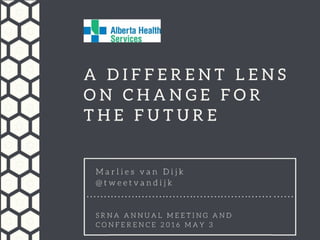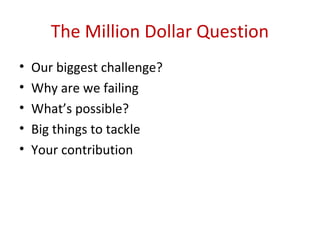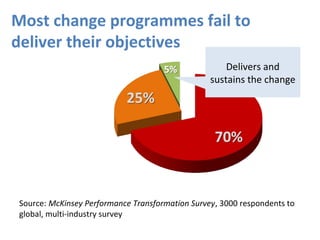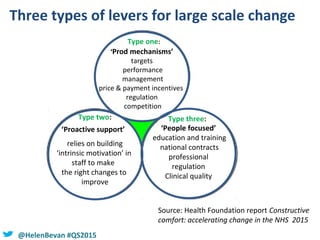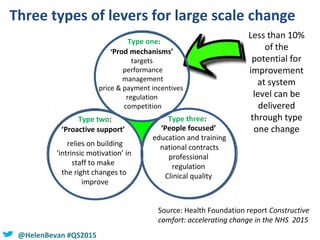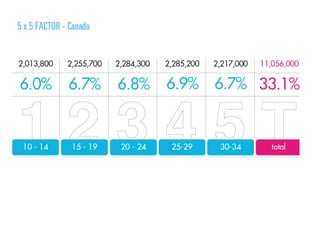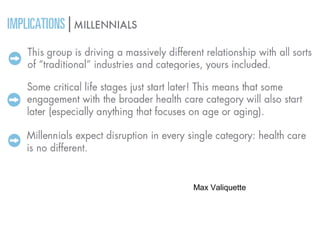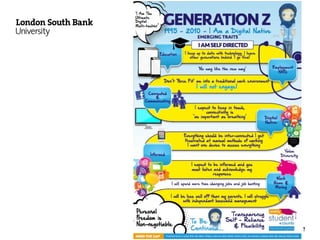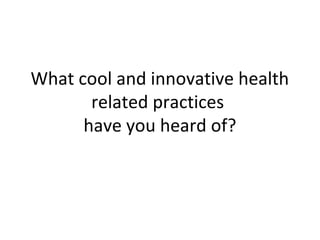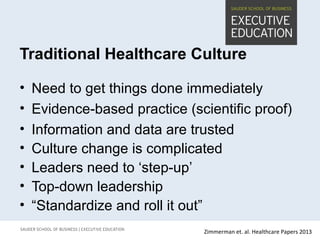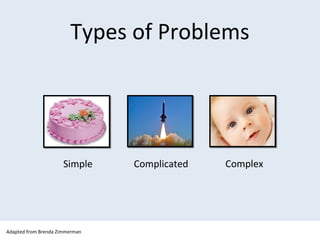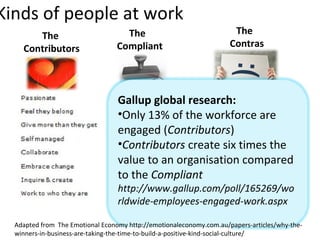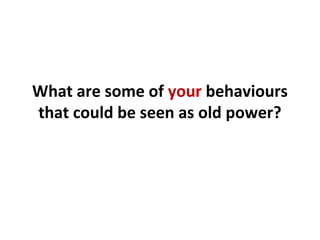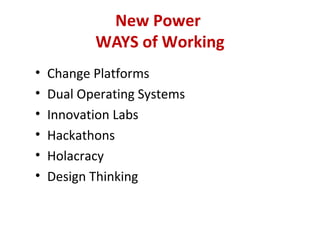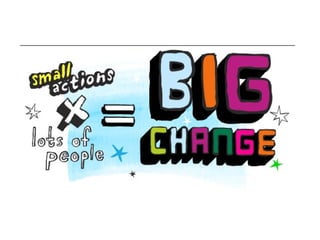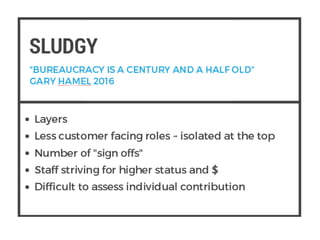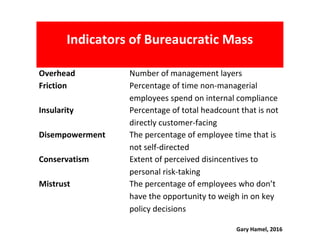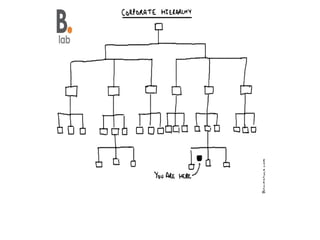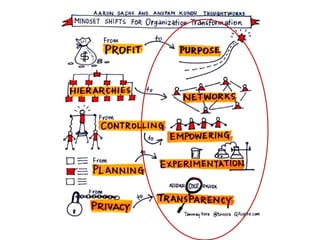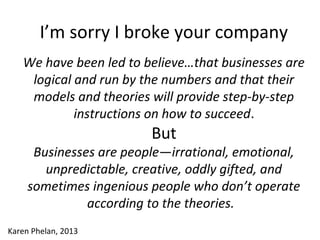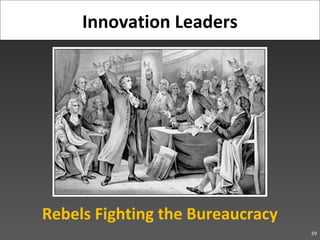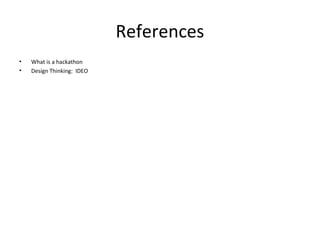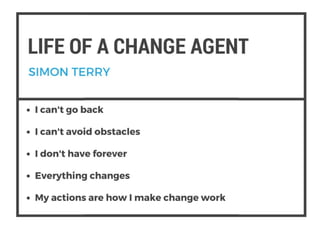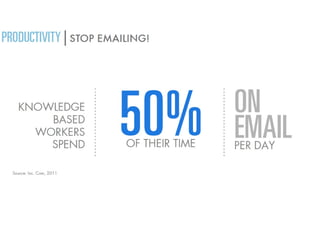New Lens on Change in Healthcare
- 2. The Million Dollar Question • Our biggest challenge? • Why are we failing • What’s possible? • Big things to tackle • Your contribution
- 4. @HelenBevan #QS2015 Most change programmes fail to deliver their objectives Source: McKinsey Performance Transformation Survey, 3000 respondents to global, multi-industry survey Gets anywhere near achieving the change and delivering the benefits
- 5. @HelenBevan #QS2015 Source: McKinsey Performance Transformation Survey, 3000 respondents to global, multi-industry survey Delivers and sustains the change Most change programmes fail to deliver their objectives
- 6. 14,000 contributions identified 10 barriers to change: Confusing strategies Over controlling leadership Perverse incentivesStifling innovation Poor workforce planning One way communication Inhibiting environment Undervaluing staff Poor project management Playing it safe HSJ journal: Crowdsourced barriers to Change
- 7. @HelenBevan #QS2015 Three types of levers for large scale change ‘Prod mechanisms’ targets performance management price & payment incentives regulation competition ‘Proactive support’ relies on building ‘intrinsic motivation’ in staff to make the right changes to improve ‘People focused’ education and training national contracts professional regulation Clinical quality Type one: Type two: Type three: Source: Health Foundation report Constructive comfort: accelerating change in the NHS 2015
- 8. @HelenBevan #QS2015 Three types of levers for large scale change ‘Prod mechanisms’ targets performance management price & payment incentives regulation competition ‘Proactive support’ relies on building ‘intrinsic motivation’ in staff to make the right changes to improve ‘People focused’ education and training national contracts professional regulation Clinical quality Type one: Type two: Type three: Source: Health Foundation report Constructive comfort: accelerating change in the NHS 2015 Less than 10% of the potential for improvement at system level can be delivered through type one change
- 15. Max Valiquette
- 16. Max Valiquette
- 18. What cool and innovative health related practices have you heard of?
- 19. Traditional Healthcare Culture • Need to get things done immediately • Evidence-based practice (scientific proof) • Information and data are trusted • Culture change is complicated • Leaders need to ‘step-up’ • Top-down leadership • “Standardize and roll it out” Zimmerman et. al. Healthcare Papers 2013
- 20. How we tend to view the healthcare world: A B What it tends to be like: W BBLACK BOXBLACK BOX
- 21. Simple Complicated Complex Types of Problems Adapted from Brenda Zimmerman
- 22. In a Linear World • One size can fit all • Process solutions work (Lean, Model for improvement…) • Copying best practices makes sense • Top down leadership (“develop the program and roll it out”) works • Checklists work
- 24. For every complex problem there is a solution that is clear, simple, and wrong HL Mencken
- 25. MOMENT
- 26. Kinds of people at work The Contributors The Compliant The Contras Adapted from The Emotional Economy http://emotionaleconomy.com.au/papers-articles/why-the- winners-in-business-are-taking-the-time-to-build-a-positive-kind-social-culture/
- 27. Kinds of people at work The Contributors The Compliant The Contras Gallup global research: •Only 13% of the workforce are engaged (Contributors) •Contributors create six times the value to an organisation compared to the Compliant http://www.gallup.com/poll/165269/wo rldwide-employees-engaged-work.aspx Adapted from The Emotional Economy http://emotionaleconomy.com.au/papers-articles/why-the- winners-in-business-are-taking-the-time-to-build-a-positive-kind-social-culture/
- 29. The Reality “What the leader cares about (and typically bases at least 80% of his or her message to others on) does not tap into roughly 80% of the workforce’s primary motivators for putting extra energy into the change programme” Scott Keller and Carolyn Aiken (2009) Source of image: swedenbourg-openlearning.org.uk
- 30. Jeremy Heimens TED talk “What new power looks like” https://www.youtube.com/watch?v=j-S03JfgHEA
- 32. Old Power Managers Words New Power Manager Words A project charter is a fundamental step to making sure our project succeeds. A general direction is a good first step; we have no idea what is around the first corner and we want to adjust if we have to. I think that we need to strike a steering committee to make sure we are heading in the right direction. I want to gather as many ideas and opportunities from as many people as possible. Role clarity is important to avoid confusion. Let’s see who feels they are good and interested at the task at hand. A thoughtful project plan will keep us on track. Assessing where we need to go as we start the work will be our guide. A literature review at the outset of our project will give us an environmental scan and help us set the course. Observing blogs, social media and conference discussions on an ongoing basis will inform our work along the way. A clear vision by our leaders is fundamentally important. A shared purpose that invokes passion and excitement will grow our community. Consulting experts to establish a direction is a key objective. Crowd sourcing ideas from outsiders and inviting diversity of thought is a key way for us to know what to do! @tweetvandijk
- 33. What are some of your behaviours that could be seen as old power?
- 34. New Power WAYS of Working • Change Platforms • Dual Operating Systems • Innovation Labs • Hackathons • Holacracy • Design Thinking
- 39. Dual Operating Systems John Kotter, Accelerate
- 43. Design Thinking
- 46. Reference
- 49. Indicators of Bureaucratic Mass Overhead Number of management layers Friction Percentage of time non-managerial employees spend on internal compliance Insularity Percentage of total headcount that is not directly customer-facing Disempowerment The percentage of employee time that is not self-directed Conservatism Extent of perceived disincentives to personal risk-taking Mistrust The percentage of employees who don’t have the opportunity to weigh in on key policy decisions Gary Hamel, 2016
- 52. Some Inconvenient truths 1. What motivates you may not motivate them 2. Let them write/tell their own story 3. Both positive and negative are important 4. You are part of the problem 5. Influence leaders may not be influential Keller and Aiken, McKinsey and Company, 2000
- 53. Some Inconvenient truths 6. Money may not motivate 7. The process is as important as the outcome 8. Employees are what they think 9. Good intentions are not enough Keller and Aiken, McKinsey and Company
- 54. Buy in
- 55. Ownership
- 56. How is this different from “sharing” best practices? “Point of Care” Ownership • Winning practices are highly sensitive to the local context • Winning practices come from those who are “touching the problem” • Practices are spread virally peer to peer • Sustained Sharing Best Practices • What worked there should work here. Variability is discouraged • Winning practices come from experts • Practices are spread in top down fashion • Often not sustained
- 57. I’m sorry I broke your company We have been led to believe…that businesses are logical and run by the numbers and that their models and theories will provide step-by-step instructions on how to succeed. But Businesses are people—irrational, emotional, unpredictable, creative, oddly gifted, and sometimes ingenious people who don’t operate according to the theories. Karen Phelan, 2013
- 59. Rebels Fighting the Bureaucracy 59 Innovation Leaders
- 60. School of Healthcare Radicals
- 62. References • What is a hackathon • Design Thinking: IDEO
Editor's Notes
- Big strategic moves fail – as they are using old processes. Organizations are struggling to be nibble – the small start ups are outperforming the big companies. Hierarchical structures and organizational processes we have used for decades to run and improve our enter prises are no longer up to the task of winning in this faster moving world. A company should reconsider strategies every few years. Hierarchy is good for running a company; but it essential that a company identified hazards and opportunities early enough. To formulate creative strategic initiatives nimbly enough – and implement the fast enough. John Kotter proposes a secondary operating system – one that complements rather than overburdens the traditional hierarchy “both and” One is rational and one is emotional. 2 essential elements of hierarchy: 1) political: managers loathe to take chances without risk and 2) culturally: we cling to the habits and fear loss of power and stature. Change management works if you have to get from A to B
- Smart phone becomes the epicentre of health
- With past or planned change days in countries all over the world! Australia England Netherlands Finland Sweden USA Scotland Wales New Zealand Jordan India More…
- http://www.buurtzorgnederland.com/
- David Naylor report
